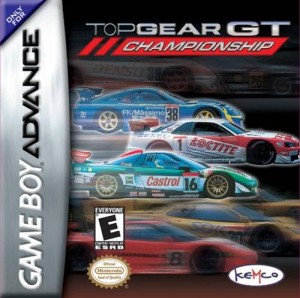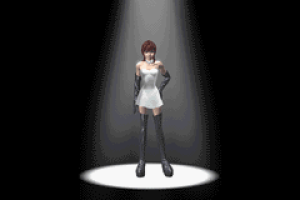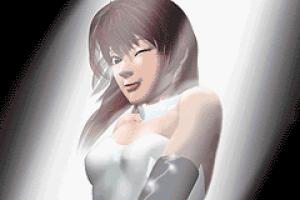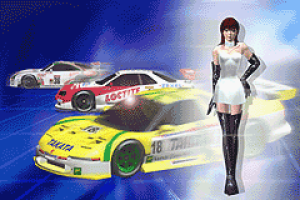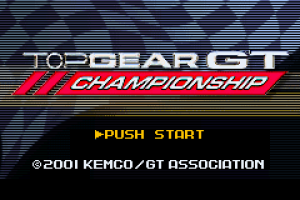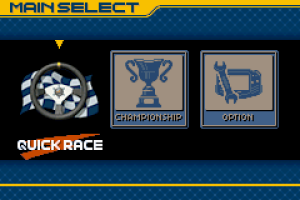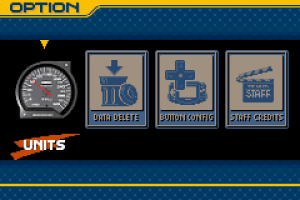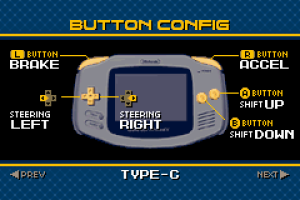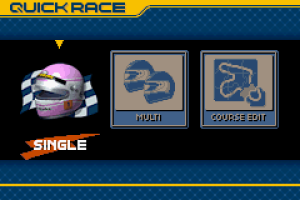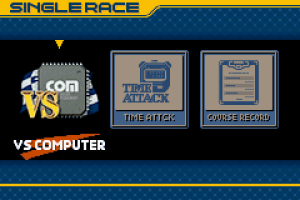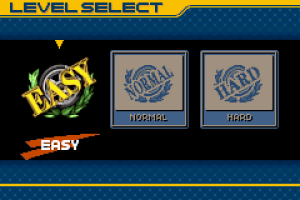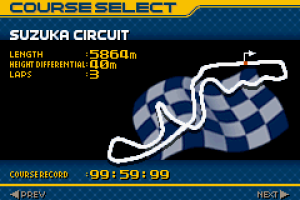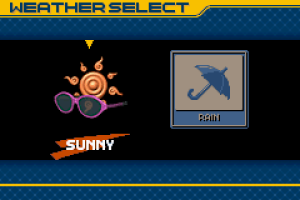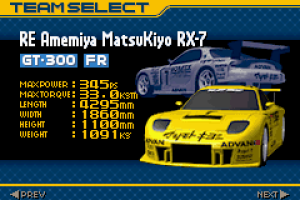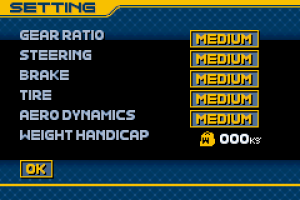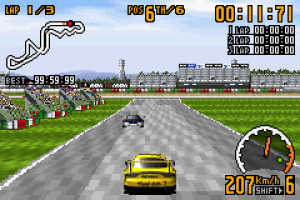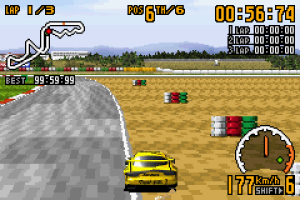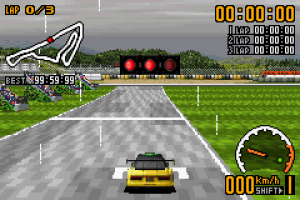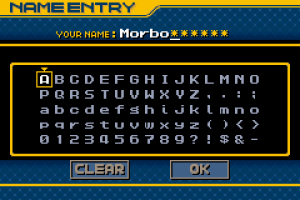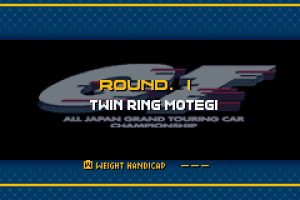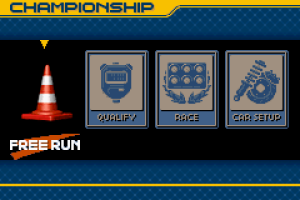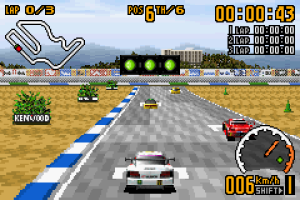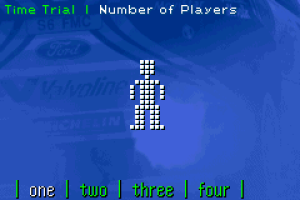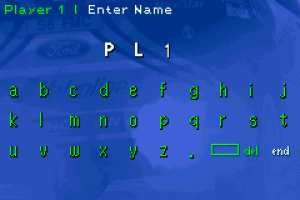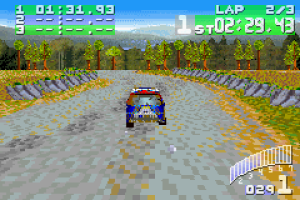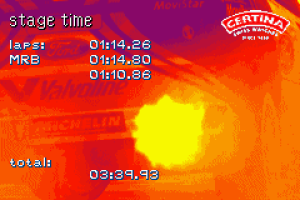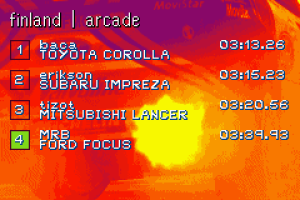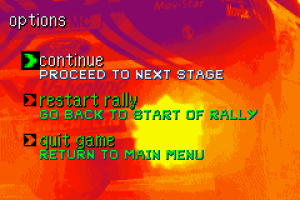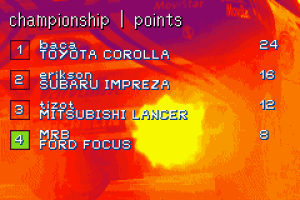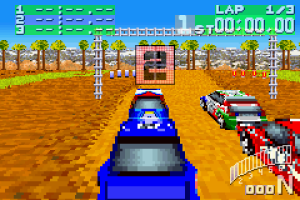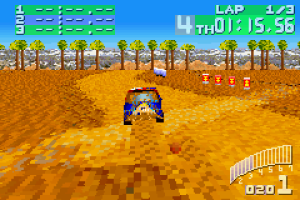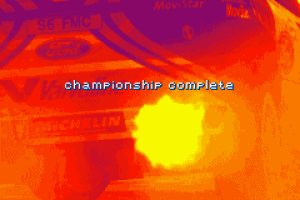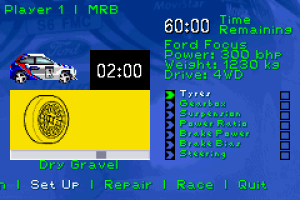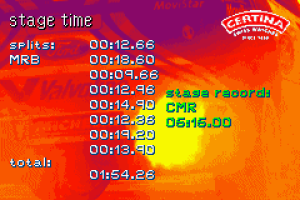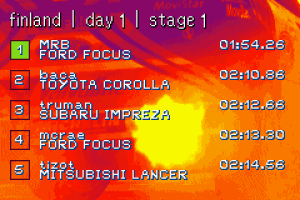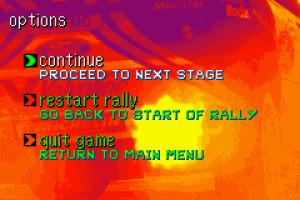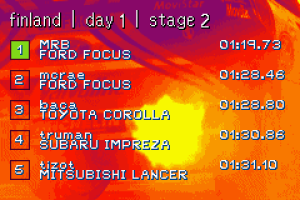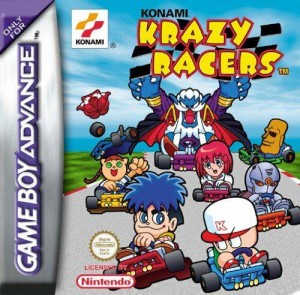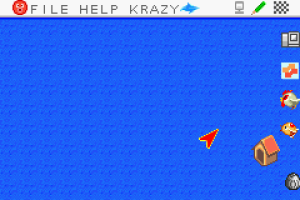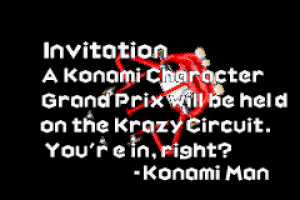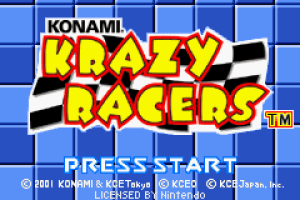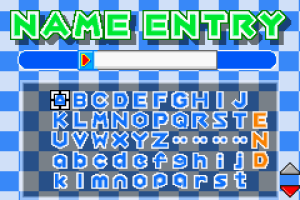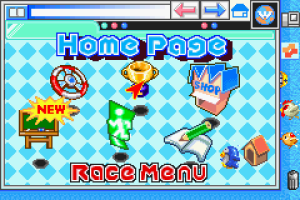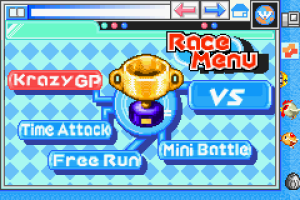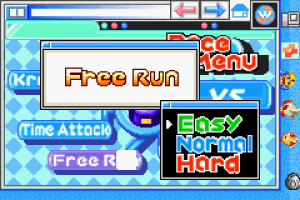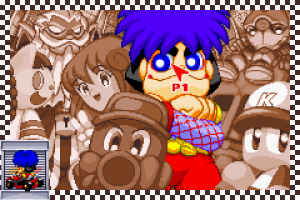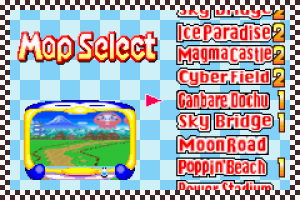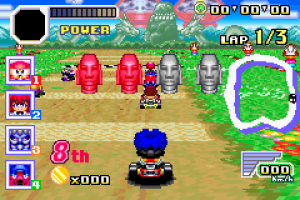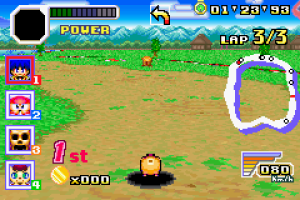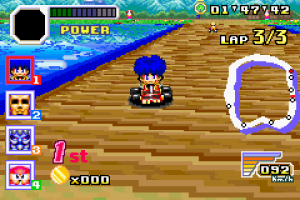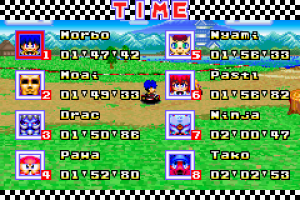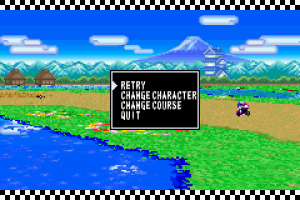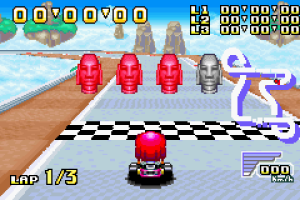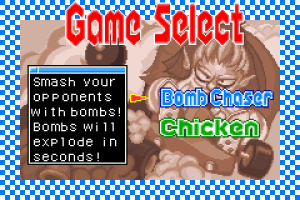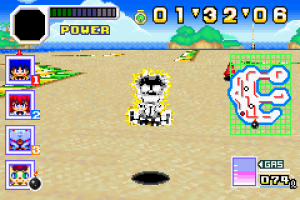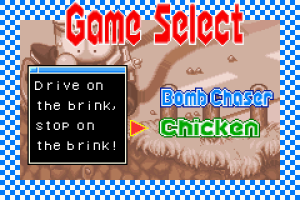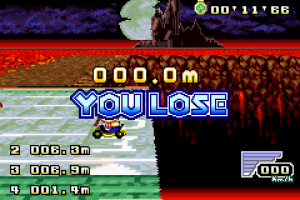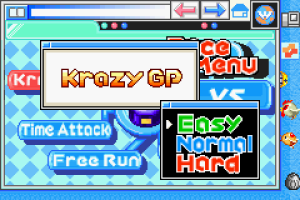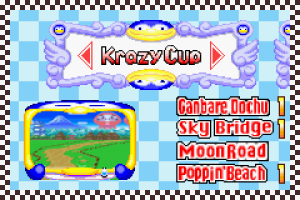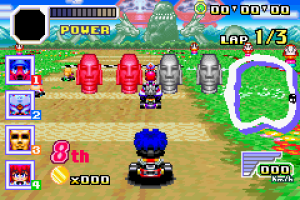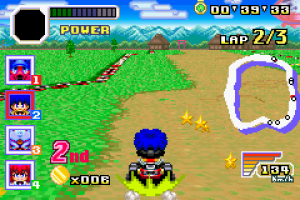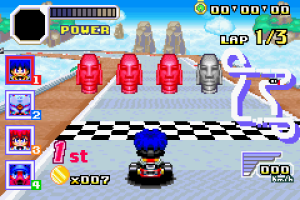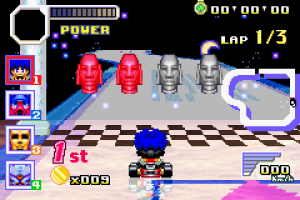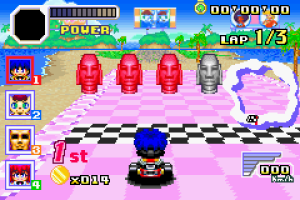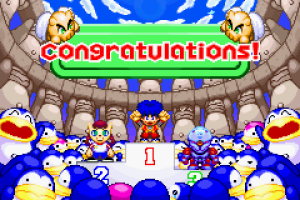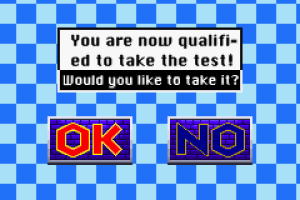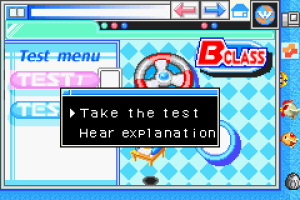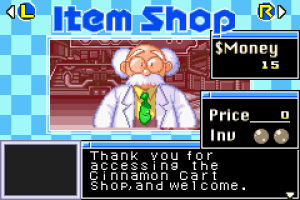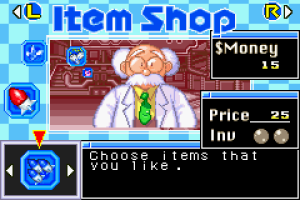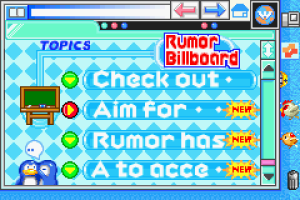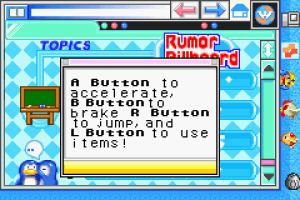We’re back into hand-held territory, and that means a step back from the realism of the sixth generation consoles like the PlayStation 2 and Dreamcast. Here we trade those features in for considerations of portability.
The Game Boy Advance was really nothing to sneeze at though. It was a 32-bit hand-held, though to me, most of the games look like they could have come straight off the Super Nintendo. The selling point of a portable system is being able to game on the go, so that will be kept in mind for these reviews too.
And screenshots are my own again, for a change. I’m playing these games on the No$GBA emulator.
Top Gear GT Championship (2001)
This is a perfectly cromulent game. Competency, thy name is “Top Gear GT Championship”.
I’m guessing that this game was originally developed in Japan, because the intro features gratuitous shots of this scantily-clad anime girl… and some cars of course.
She winked at me! I think she likes me! Or perhaps the wind has blown an eyelash into her eye. That happens to me a lot. And then sometimes it gets under my contact lens… so boy do I know that look.
Yes, this looks very Japanese. But that’s not a bad thing, no. Go Japan!
Before I mention anything else, I have to talk about the sound. Oh god, the Game Boy Advance sound. Sometimes it can be horribly messed up, and it takes on a “scratchy” sound that grates on the ears and makes an otherwise good game a little harder to bear. This one is just such a title. The music would sound alright, if only it hadn’t been mangled by Satan’s codec on the GBA soundsystem from Hell.
That can be overlooked, because thankfully there is no music during the races. Instead, the scratchy sound is used to simulate racing and engine noises, and it’s less noticeable there.
The two modes of gameplay you get are “Quick Race” and “Championship”. They function like they do in most other games that I’ve described, so I won’t rehash it all again.
The game’s options are a little limited, but you can choose whether to display Imperial or Metric units on-screen.
One feature I do appreciate a whole lot is the ability to choose from some different button configurations. The screenshot above shows the one I preferred to race with, and with my old Logitech USB controller, it was quite comfy.
The Quick Race is broken down into single-player and multi-player modes. There is also a track editor. As I’ve said before, any racing game with a track editor has a little extra replay value built-in.
Within the single race part of the game, you can choose to race computer opponents or do a “Time Attack” style race.
And right before you race, you have your choice of three difficulty settings.
Then you can choose from one of six tracks to race.
You can also choose to race in sunny or rainy conditions.
And you can choose from one of six different cars, each with slightly different specs. You also get to choose whether to drive with an automatic or manual transmission.
Like any good modern racer, you can customize your vehicle to a certain extent. This game has a surprising amount of customizability, allowing you to alter the six different aspects shown above.
The start of the race brings you to a 3rd-person, sprite-based view. Remember sprite-based graphics? Before polygons?
Things are pretty easy to see, and there weren’t any points in the game where I got frustrated and wished that I could alter the camera angle or see more of the road ahead of me. There isn’t any pop-in that I could speak of.
The action is decently paced, though it’s not blazingly fast or anything. This is still just the Game Boy Advance we’re talking about. There are even “elevation” effects, but these are merely lifting and lowering of the horizon, so it’s ultimately unconvincing. Still the overall racing effect is there, and it looks like a 16-bit racing game that would have made for a damn great Super Nintendo game.
Here’s a race in the rain. Again, the graphics are good. The way the cars handle is also done well. Each car handles its own way, and customizing it affects the speed and handling accordingly. Effects in the game are noticed immediately.
The Championship mode allows you to enter your name…
…then you are whisked away to the first race. You will be shown the track and the current weather before you begin.
You can practice the track if you want, or qualify for your position or go directly to the race. You can also tune your car and go back to free run so you can really get things just the way you want before you start the actual competition.
Like any good racing game, it takes a bit of practice to master the way it plays, and it holds up well after repeated playthroughs. This is a solid, well-built racer that has obviously had a lot of time and attention to detail put into it. So how come it doesn’t rise to the level of being great?
Simply because it’s on the Game Boy Advance. The hardware really limits what can be done with a game like this, especially in screen resolution. The screen is tiny and constricted, and though it was possible to make racing games for portable systems, was it really worth doing?
Still, it’s one of the best such games that I could find for the GBA. And it’s not terrible. If you have a GBA that you need to occupy some time with, and you need to get your racing fix, this one will fill the gap admirably. As an added bonus, you get to be winked at by the cute anime girl.
Colin McRae Rally 2.0 (2000)
This is a great game. But I have to get something out of the way first. There is a way way WAY better version of “Colin McRae Rally 2.0” available for PlayStation. That version is one of my favourite PlayStation racing games, and the only reason I didn’t review it when I reviewed PS1 racing games is because I needed some racers to review for the Game Boy Advance.
And of course it goes without saying that if you’re looking to play this game, the PS1 version is where it’s at. But this one is the best racing game I could find for the Game Boy Advance. It’s a very good port, and it handles the limitations of the hardware as good as can be expected.
The first thing you will notice when you start to play is the extremely tinny sound. The whole game is like this – there is just no bass. The original GBA hardware wasn’t going to pump out any bass, but didn’t they figure that anyone might want to plug some headphones in? Playing this on my PC sounded mighty strange, like I’d forgotten to turn the subwoofer on or something.
The game options and settings are a little limited, but again here, the shoulder buttons can be used to accelerate and brake, which is what I prefer.
The game is split into “Rally” and “Arcade” sides. Let’s look at Arcade first. There are three modes here: “Championship”, “Single Race” and “Time Trial”. These do what they say on the tin.
We’re looking at the “Time Trial” first, and you can choose the number of players.
You can enter a three-letter name…
… then choose your car. You can also choose whether to drive manual or automatic transmission. These are standard choices in the “Arcade” side gameplay modes.
The graphics are pretty nice for a GBA game, and they’re among the best I’ve seen. The racing action is fast and the code seems to have been expertly optimized.
However, there are some glaring flaws that can’t be overlooked. One is the lack of a mini-map. This is the first racer I’ve played in a very long time that didn’t have one, and it showed me just how much I rely on such a feature. An even bigger problem – and one that is exacerbated by the lack of a mini-map – is the excessive pop-in.
Features and barriers along the side of the road don’t appear on the screen until very late in your car’s approach. This game provides by far the worst example I’ve seen of pop-in. What’s more, there is “pop-out” too, where the same roadside features that appeared too late to guide you along the track suddenly vanish from view before they should. Certain features only appear then in a narrow band along the middle of the screen.
That really brings down the quality of the game, but I don’t think it could have been avoided with the GBA hardware. There had to have been some trade-offs for this game to appear on a hand-held console at all, and other than the above issues, the graphics are impressive.
Here’s the start of a single race. You get to choose the race in either Finland, France, Sweden, Australia, Kenya, or the United Kingdom. In the “Arcade” side, each of these is a closed track, and each has unique terrain.
Each of the available cars has slightly different handling characteristics, so some driving around in each one is necessary to find the one that suits your driving style.
The driving in this game plays more on the simulation style rather than the arcade style, and it can be quite challenging to maintain control of your car.
After each race, you get to see a multi-camera replay, which looks pretty spiffy.
In this “Arcade” side, there is only one song that plays during the races, and it can’t be turned off. You better get used to it.
When playing the “Championship”, you cycle through the races,and you are given points for winning races and placing well.
At least I didn’t finish fifth… wait a sec… there are only four racers…
The choice is yours whether to proceed.
This is the closed “France” track.
The driving here definitely takes some practice.
More race results, Morbo isn’t doing so well.
Here is “Sweden”.
It’s extremely hard to control your car at any speed in the snow and ice.
From there we go to “Australia”, which is dirty and muddy.
Note how my car gets all filthy after a while.
Now here we are in “Kenya”.
I found this track to be particularly hard to follow, and the pop-in was messing with my perception here.
Finally, up in “England” somewhere.
Another very challenging drive.
And even though I lost…
I got the message “WELL DONE” and some fireworks. Hooray for me!
The “Rally” side of things is what the game is really about, and you don’t have to listen to that one song over and over as you race here. This side is divided into a “Championship”, “Single Rally”, “Single Stage” and “Time Trial”.
You can choose your difficulty level right when you start.
There are three countries in the “Rally” side (Finland, France and Sweden) with two races in each. When you get into a rally race, you can check out some information about it beforehand.
This is important because you can do some car setup before you race. You need to choose the appropriate tires, among other customizations before setting out on these open Point-A to Point-B races.
There is also a screen for repairs, which come into play during the second race. This all depends on how banged-up your car gets during the first race.
You’re counted in, and you race alone, though your time will be compared to other drivers.
You get a co-driver who babbles instructions to you, and this can thankfully be turned off in the game options. You also get these lovely little direction arrows popping up telling you where to go. That’s not confusing, is it? (They’re actually in order left-to-right)
There is a damage meter above your time on the screen so you can see how bad you’re messing up in that respect. And thankfully there is no music here.
Stage times are shown after each race…
… and final standings follow.
You are then given the option to proceed to the next race.
Again, you are counted in.
The “Rally” side is a lot more fun, and it’s definitely where the serious racing in this game is at. But it does lack the thrill of the other cars on the track, so it is nice to have the “Arcade” side too.
And look at those times. The Novice mode is way too easy, methinks. Next time I play this, it won’t be in that mode.
Then again next time I play “Colin McRae Rally 2.0”, it will be on the PlayStation. The only reason to play this on the Game Boy Advance would be if you actually own the hardware and still use it as a portable time killer. Then by all means, go and find a cartridge and get your racing fix because like I said, this is the best racing game for the GBA.
Konami Krazy Racers (2001)
The Kart Racing genre can be rather hit or miss, since it’s essentially a simple formula that relies on so few elements done well to bring everything together to make it work. One of these elements is familiarity.
Mario Kart had, of course, Mario and his familiar friends to draw from. Crash Team Racing had Crash Bandicoot and his friends. And who could forget Pomplain Forst Longboat Sailing in Outer Spave, with Pomplain Forst, Scurvy Kveldulf, Lyn The Nice, Lord Evilham and Øysten The Unwise?
Of course, since this game came out in 2001, the interface just has to mimic a PC, an email client, and a web browser, doesn’t it?
You’ve got mail!
“Konami Krazy” Racers feels like a win to me. I’m just relieved they didn’t call it “Konami Krazy Karts”. These characters are all unfamiliar to me, except for good old Goemon. (He’s better known to people on this side of the globe as the Mystical Ninja.) The lot of them might be more familiar to Japanese gamers, or to fans of Konami games specifically, but this is one of the more obscure bunch of characters to base a kart racing game off of.
You’ve got to have a name of five characters or less. That’s alright, with the extremely annoying menu music here, you won’t want to be hanging around in these screens too long. Think an overly excited high-pitched doo-wop group singing “MY MY MY MY MY MY RACING!!” over and over and over and over again to a frenetic dance beat. It’s bad. Thankfully, the GBA audio doesn’t sound all scratchy in this game, so the terribly annoying song doesn’t sound terrible.
And in your browser-like home page, you can access the game’s functions. More about these later.
There are four gameplay modes and multiplayer.
“Free Run” is actually a single race with you racing against seven computer opponents. And thankfully, by the time you get here, the music changes. It’s actually quite good during the rest of the game, especially during the races.
You can choose one of the eight characters when you begin. I’ve got to go with that blue-haired, kiseru-waving freak.
In this mode, you can choose any of the game’s tracks.
The screen has a pretty good layout, though things can be a little cramped at times. This game takes advantage of those “mode 7” graphics that the Super Nintendo had, and uses hardware scaling and rotation effects to provide a smooth racing track effect on the screen.
Like any good kart racing game, there are weapons and power-ups to use and have used against you. I’ve just been turned into a pig.
The mode 7 graphics on the GBA look a lot better than they did on the SNES, if they’re handled right. It’s just too bad about that smaller resolution.
Final standings are shown after every race. You can see here the names of these Konami characters. According to Craig Harris at IGN:
“You’ve got Dracula from Castlevania, and Goemon from Mystical Ninja, as well as the Ninja from Metal Gear Solid and Moai, the stone head from Gradius. Then we get to the more obsure: Takesuke from Parodius, Pastel from Twin Bee, Nyami the Cat from Pop’n Music, and even a big-headed player from Jikkyo Power Pro Baseball.”
After your single race, you can choose what to do from this menu.
The “Time Attack” mode features just you racing as the character of your choice in whatever track you choose.
There are two types of “Mini Battle”. The first one is “Bomb Chaser”, with the instruction s shown in the screenshot above.
This is a course where you chase your opponents around and try to blast them with bombs, while trying to evade them as they do the same thing to you. You can see I’ve just been blasted by lightning.
The other one is a game of chicken with the sheer edge of a track.
You and three other racers start and drive off at full speed…
… and whoever stops furthest along wins. It wasn’t me that time.
There I go. That only took ten attempts.
The main game is of course the “Krazy GP”.
There are four different “Cups”, each with four races. After the first (shown above) you will need to get a license in order to race in the next one. These Cups get progressively more difficult but they’re all extremely fun and challenging.
Here’s the first race in the first Cup. There is a lot of detail in all of these tracks, and it’s obvious that a lot of time and testing went into this game in order to polish everything and make it as good as it could be.
Here I am after getting a momentary invincibility power-up. One drawback I find with mode 7 racing games is that I never seem to see enough of the track ahead of me. The same problem affects this game, though I think the cramped screen size is more to blame here.
Here’s the second race. Some of the turns in this track are quite narrow, and going off the track will slow you down considerably, so you must learn when to take your finger off that accelerator button.
Track number three in the first Cup. Properly timed use of weapons is also important. There are also jumps that require you to drive over activated spots, and missing them makes you fall, so you need to know where to drive there too.
This is track number four. This one is starting to get tricky, and there are some palm trees in the way that need to be avoided. Some of these tracks should be practiced first in the “Free Run” mode, especially the trickier ones in the later Cups.
And winning is its own reward. My god, Goemon’s fists are almost as big as his head.
After winning the first Cup, you get a chance to take those license tests.
I bitched about this kind of thing in my review of Gran Turismo 3 for the PS2, but the tests here aren’t so tedious and dull, and they’re not nearly as plentiful.
The “Item Shop” is all about spending the coins you drive through as you race along the tracks on your way toward winning.
All you can really buy are the same things you can get by driving through power-ups, but what else are you going to do with those coins?
And to complete the web page metaphor, there’s a “Rumor Billboard”. Aside from giving you another chance to rock out to the “MY MY MY MY MY MY RACING!!” song, it provides a place for you to read stuff that the game didn’t want to display anywhere else.
Kind of a useless feature.
But other than a few annoyances, this game definitely rises above most of the multitude of kart racing games. Even though its characters are kind of rare to say the least, it’s a very well-made game with a lot of charm on its own. The Mini Battle features are a neat extra touch, and the racing is of course solid and fun.
I recommend this one highly, even if you don’t have a GBA. You should download No$GBA and give it a spin, or look for it on some virtual console service if it’s out there. The GBA cartridge can get a little pricey on ebay, but I think it’s worth it if you can find a good deal there or somewhere else. Definitely keep this game in mind if you’re a kart racing fan.
